#mille fluer bantam cochin
Text
Frizzling
Frizzling is an incomplete dominant mutation.
On chickens with one copy of the gene, feathers curl back towards the head instead of lying flat.
(Buff Frizzle Cochin bantam that I absolutely love!)


Absolutely precious black frizzle taking a nap!


Here is another (I think it might be the same bird)
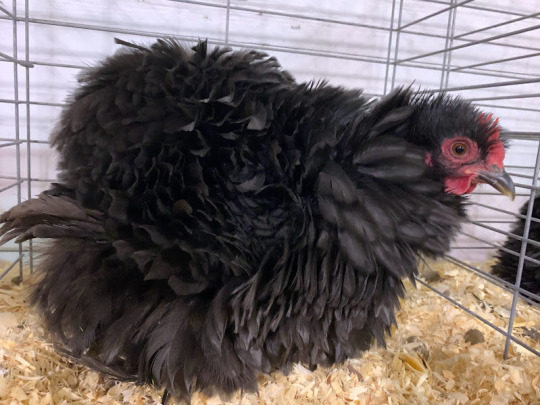
Frizzled mille fluer d'Uccle!
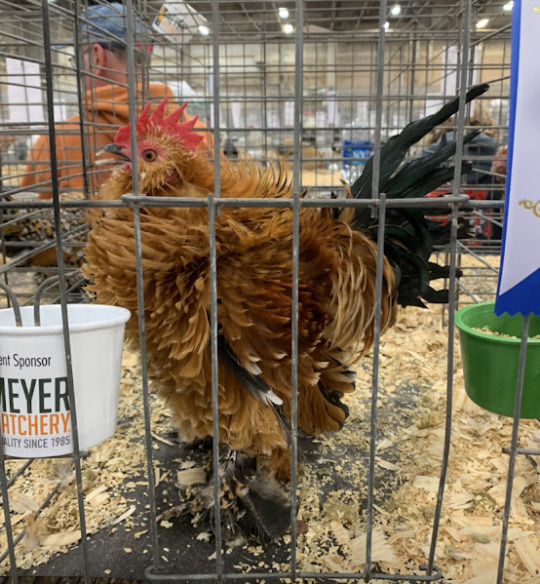
I don't even know the color of this Frizzle Serama, ginger golden? Or something!

Frizzles are flightless and less cold-hardy than other specimens. By creating controlled environments this shouldn't be a major issue.
Frizzle is accepted to be shown in any breed in the APA and ABA standards, it's just another variety. That doesn't mean the gene is present in every breed. I've never seen a frizzled d'Anver.
Frizzle shouldn't be bred to frizzle because homozygous frizzles known as frazzles have health issues including brittle feathers, baldness, and shorter lives.
Frizzled individuals should be bred only to smooth individuals.
3 notes
·
View notes
Text

Two chicken pens put together. My bantam cochin (hopefully) lavender carriers have technically BEEN together, but shh.
These are the sussex/cochin cross trio. Their eggs are either getting eaten or hatched on site, and no chicks will leave the property. I will only be keeping a couple mille fluer patterned chicks with feathered legs. Which I said is ... 9%? probability per chick.
I am SO excited to start getting eggs from these girls and hatch babies.
4 notes
·
View notes
Text
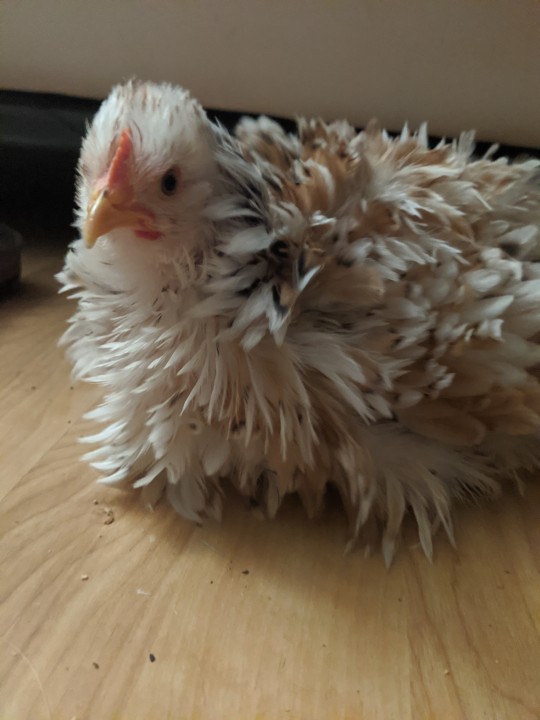
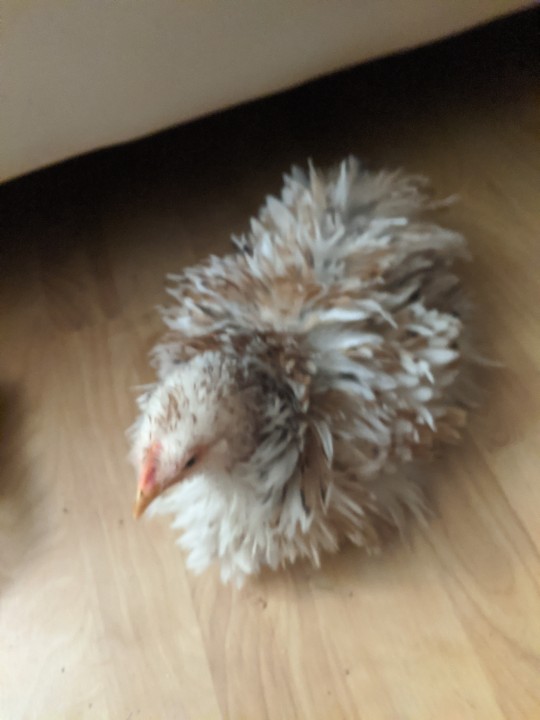
she...
#bantam cochin#frizzle chicken#chicken#chickens#mille fluer#mille fluer bantam cochin#her name is tink :)#photo
11 notes
·
View notes
Text
How to Raise Bantam Chickens
Are different methods used to raise bantam chickens? When looking at all the options for types and breeds of backyard chickens, you will notice the bantam breeds are listed separately. Usually the heading at the hatcheries is “bantams” or possibly select breeds of bantams. From the beginning of our chicken raising, over ten years ago, we have had at least a few bantams in our flock. The last two years, we added more variety and some specific breeds of bantams and learned much about how to raise bantam chickens successfully. I do think bantam breeds can be among the best backyard chickens.
Why Raise Bantam Chickens?
Bantam chickens can be the perfect choice for small scale homesteading, particularly on small lots. The size of bantam chickens means that they require much less space per bird. The coop can be smaller when you raise bantam chickens. The impact on your grass and any exposed gardens may be less too. Bantam chickens can be in the range of one third to one half the size of their standard breed chicken. And the best part about choosing to raise bantam chickens – they still lay delicious homegrown fresh eggs. More on that later in this post.
Bantam Polish Rooster
Bantams need 1/3 of the coop space inside, and the run can be considerably smaller, too. Some Bantam breeds, such as the Silkies, need extra protection from the weather and should have a covered run, in order to stay dry. Depending on the breed, tolerance to cold will vary. Cochin Bantams will do quite well during cold weather. Tiny Serema chickens might need some extra protection and warmth.
What are Dwarf Chicken Breeds
Dwarf chicken breeds are true bantams. They are only found in the small size and have no full sized chicken counterpart. Olandsk Dwarf chickens are an example of a true bantam breed. Comparing the bantam breeds we have with the Olandsk Dwarf chickens shows that the dwarf breed is noticeably smaller than the bantams.
Other bantam breeds may be the result of careful breeding and selection for small size. Consider the Brahmas, Cochins, Rocks, Seabrights, and Mille Fluer d’uccle as possibilities.
Olandsk Dwarf Rooster
What Breeds are Available in Bantams
This can vary. There may be a bantam variety of the breed you want from a private breeder if you don’t find them at a commercial hatchery. In addition, hatching eggs in an incubator can be a rewarding way to start to raise bantam chickens.
Hatching bantam chicken eggs takes less than the standard 21 days that is normal for hatching standard size chickens. Make sure you allow for this difference when setting up an incubator and turning eggs. Most of my bantam chicks have hatched at 18 or 19 days of incubation. It is important to stop the egg turning at day 16, to give the chick time to get into hatching position.
Can Bantam Chickens be Kept with Full Size Chickens?
My advice is to plan to keep the bantam flock separate from the full size chickens. I have a few reasons for recommending this practice.
If you have a full size rooster, he may injure or kill a bantam hen while attempting to mate.
Larger chickens can be aggressive in the pecking order and harm a bantam chicken.
It might be hard for a bantam to stay warm if none of the full size chickens will allow it to roost with the flock.
We have had a few bantam chickens in with our full size chickens. Currently, we have one coop that is very successful and has a mix of chicken sizes. I have also experienced some losses from housing bantams with full size chickens. Our breeding flocks of Cochin bantams are housed separately.
If you choose to house your bantam chickens with the full size chickens, remain aware of the potential problems and act quickly at signs of trouble.
Bantam Chicken Eggs – Are They Too Small?
Bantam chicken eggs are not too small to use! In fact, I was surprised by how large they were, considering the size of the chicken. The Dwarf hens in the coop lay a much tinier egg than the bantams. Bantam eggs can range from under 1.75 ounces to a tiny 1 ounce. Bantam eggs also have a higher yolk to albumen ratio. This might be a factor in some baked goods.
Adjusting the Recipes When Using Bantam Eggs
The following are standard sizes of eggs.
Jumbo 2.50 ounces
Extra Large 2.25 ounces
Large 2.0 ounces
Medium 1.75 ounces
Small 1.50 ounces
Recipes are written for large eggs, in most cases. If you weigh your bantam eggs, you can easily adjust the amount of eggs you will need when you raise bantam chickens.
2 eggs (6.75 ounces) called for in a recipe will require 4 to 5 bantam eggs, approximately.
Bantam Breeds are Often Good Broody Hens
Another feature of many bantam hens is their tendency to go broody. And these hens can be very persistent broody hens. Many people like a good broody bantam on the farm, for hatching out replacement chicks in both full size and bantam size.
Bantam chickens have many positive features that make them a good addition to homesteads and farms, large or small. They can be perfect for children to raise and show in competitions too. Their hardiness and good disposition make them a good choice for a backyard flock. The fact that they require much less space and less food makes them a good choice when those are important factors to consider.
How to Raise Bantam Chickens was originally posted by All About Chickens
0 notes
Text
Long chicken rambles with pictures as I try to figure out what I'm doing next year.
My biggest problem that I'm encountering is I have so many ideas and so little space, right? I have the pen that I built this fall, that's to be sectioned off into two separate sections that can hold about five to six chickens each. It's currently my overcrowded oldest grow-out pen that I need to dig out all the straw from so that the ground can actually drain. It's a mess in there and straw is detrimental, just fyi.
That's two larger breeding groups. I also have my cock block pen in the barn, which can hold around seven or eight birds. That's my younger grow-out pen at the moment, also where all the birds that for some reason can't brave the grow-out pen go so that they can get some fluff back to their feathers. Originally, the cock block was designed to be split in half, but I will not be doing that. I kind of like it just the way it is.
I have a chicken tractor that I built a few years ago. It can hold about a trio. It currently has my bantam hold backs.
I miiiiiight be able to make room for two or three pairs and maybe another trio. Maybe. Bantams go in rabbit cages for breeding season, so they're not an issue.

So first project bird that I have is with my big boy. I love love love this cockerel. He's half cochin, half sussex. I have one matching pullet to go with him, and if I have the room, another younger pair of him with shitty quality black. The purpose of this project next year is to create a speckled sussex pattern onto large fowl cochin - or a proper mille fluer cochin. I believe when I did the math, I have a one in eleven? chance of hatching out just the chicken from him and his lady. They're both mottled, so that's one less recessive that I have to worry about. They carry for partridge. They both also have one copy of columbian pattern AND mahogany, it just doesn't express on black.
Honestly, thinking of it now, I think I'm wrong in my earlier math. Chicks have a 25% chance of hatching out partridge, and then a 75% chance of at least one copy of columbian and then of mahogany. I certainly don't need them to be homozygous in either of the dominant expressing genes. That's a mere 14% chance of hatching out the visual color I'm after. That's a one in seven chance.
I might have issues with foot feathering, putting f1 birds together instead of back to a cochin, but that theoretically puts me at a 10.5% chance of hatching the color with foot feathers, which is still better than one in eleven. (Though I explicitly remembering coming up with 14% so I think I just remember the fraction math wrong. I don't think my math was wrong, just faulty memory.)
ALL THIS TO SAY - I want no less than a trio of phenetically mille fluer cochin out of this pen. Then I say goodbye to all my f1s. *cry*
Because ohmydear just look at that cockerel. He's gorgeous. Very striking, even if he makes a shitty cochin.
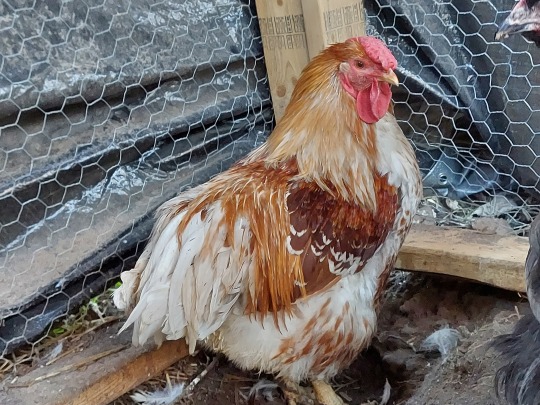
Next project that is of utmost importance involves Mr. Wyandotte sir. This cockerel - oh I went through SO MUCH trouble to get him and he's just amazing. I LOVE how well he's growing up, especially since I got him, and I'm so so so excited for the project he'll be involved in.
So the thing is, I don't have any gold laced cochins. None. Zip. I am NOT messing with dominant white and silver so ... I'm putting him over a couple partridge hens. My partridge are not good quality, but they'll get the project started. At the very least, their offspring will have some feathers on their feet and their combs will be split to single.
Using a cock with homo dominant white will result in dominant white pullets and cockerels. I'm just going to have a mess with lacing (and breeding out leaking black). HIS lacing isn't great, but buff laced is a project in wyandotte as much as it will be for me in cochin. I'm not sure how dominant white plays in hetero form, but I'm sure I'll find out next spring.
Hopefully I get some choices in pullets and cockerels out of his pen and get to keep the best lacing, because they'll be het in EVERYTHING. Pattern, melanotic, columbian - but thankfully those are ALL dominantly expressed. What really works for me on this is that both wyandotte and cochin work their laced varieties on the partridge base, so ... I don't have to mess with extension genes on this project.

A less important project, but a project that I have an f1 cockerel for anyway, is blue laced silver. This boy is a result of a silver laced cochin over a blue laced red wyandotte. So he's het silver, which causes some CRAZY gold leakage. But considering his mother should be MAHOGANY as well, it's not gold leakage as much as RED leakage.
This boy has better lacing than ANY other laced bird with feathered feet. Quite possibly any laced bird on the property.
I know I've talked about this boy and stressed over the future possibilities with him before.
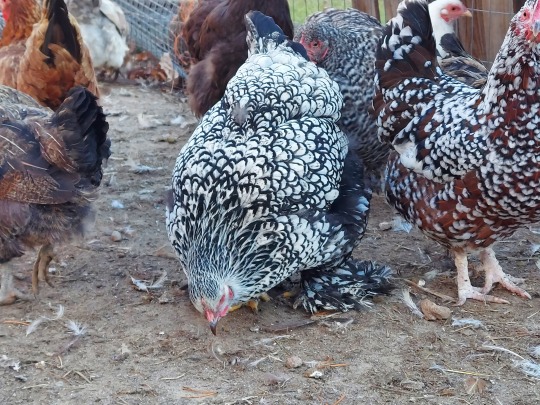
I think I want to put him over both silver laced girls that I have. Theoretically, I make half boys with his level of leakage, and half boys with the proper homo silvering and (please) no leakage. And half silver pullets, half gold pullets. Then half of ALL THOSE, blue.
So, keep anything blue and silver, of course. But I'm really tempted to keep everything not gold, but RED laced with blue as well. Which will be all pullets, but ... no, I think I will. I'll keep the blue laced red and maybe blue laced gold because THAT WAS AN ORIGINAL GOAL.
My problem with the silver laced is that my pure silver laced cock died just a couple weeks ago. Out of the blue, he just dropped dead in the main flock. So fuck - I might just keep anything silver laced, idfk. Just get rid of the yellow laced (ie het silver) cockerels, I dunno.
(By the way - that sussex hen beside the silver laced hen is one of the probable mothers to big boy. That's the color I'm seeking in that project pen.)
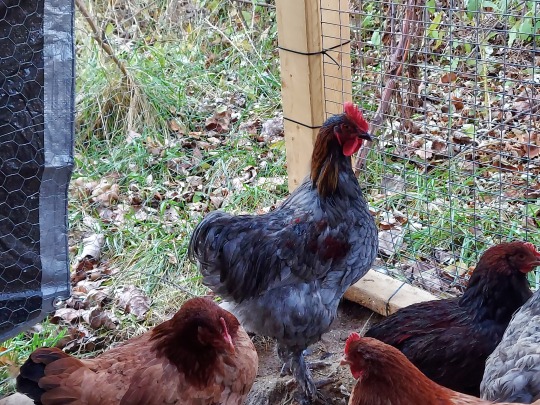
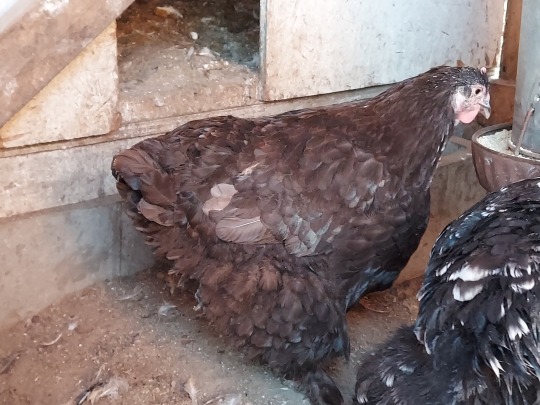
Next big big project is chocolate. I have one older boy growing up that is out of my mauve splash cochin hen, and I have one older boy growing up that is out of the chocolate orpington. I have my chocolate hen that's actually really nice now that she's grown her feathers in. Finally. I miiiiight have another cockerel in the youngest hatch that's out of that mauve splash hen, but it's mostly a brooder full of pullets. Which are useless to me in this project. How often do you hear complaining about hatching out a ridiculously disproportionate amount of pullets? I also miiiiight have a chocolate cockerel out of the orpington hen and then mauve bantam cochin. If that is a boy, I'll keep him on reserve.
I actually am a little impressed with how the type is coming along on this blue cockerel. He's leaky as fuck, which is incredibly annoying. For one, he's out of two solid birds, so where did it come from? And breeding out leakage is one of the last things I want to do in my chocolate project. The amount of leakage on him suggests that he's NOT from the mauve splash hen, but I have absolutely nothing else that he could be out of but an even better blue hen. Ironically enough, the black that's most likely out of the orpington is almost as leaky, so I'm not sure what's going on here.
I'll know within a couple hatches whether or not he's split for chocolate. If I hatch out zero chocolates, he gets eaten and I substitute in the orpington cross cockerel(s).

I know that I'm putting at least two of my nice hens under him. I'll probably give him the mottled hen and the typey black pullet I have growing up. I don't know if I'm going to put the chocolate hen under him. If I have the space, I'd really rather she got paired up with the nicest blue cockerel that I have. I don't want to work with mauves, but I'm not about to be a chooser. I'll be getting mauves out of the blue cockerel anyway.

I have three blue cockerels and a splash cockerel growing up. I somehow got every one in on this picture. The lovely raggedy guy front and center is the cockerel I hatched out of the blue hen this year. The other three, I bought. I technically have the one I hatched up for sale because his comb is an absolute mess, but he has some very promising type.
I don't know if I'll be using a single one of these boys next spring, but I want them around to see if I can use them to improve on the type I already have grown up. But I do know that if I have the space, the best one will get paired up with my chocolate.
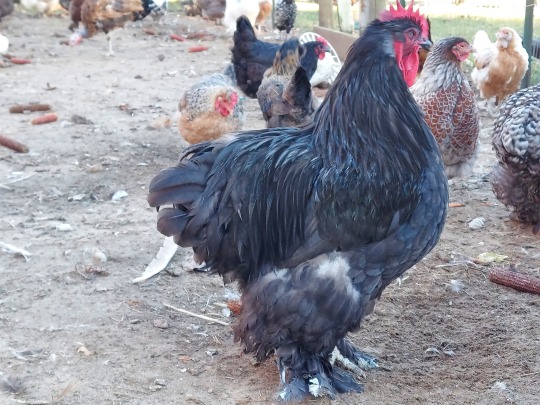
My black boy is the main man from this year. He's filled out SO MUCH these past couple months since I took him out of the breeding pen. He's almost impressive. I love how much his chest comes forward, but I would like to see a lot more depth to it. His tail has filled out immensely this year, but he still needs so much more depth to it. He's still better than most cochins I see around me. But this is the boy to beat in my programs.

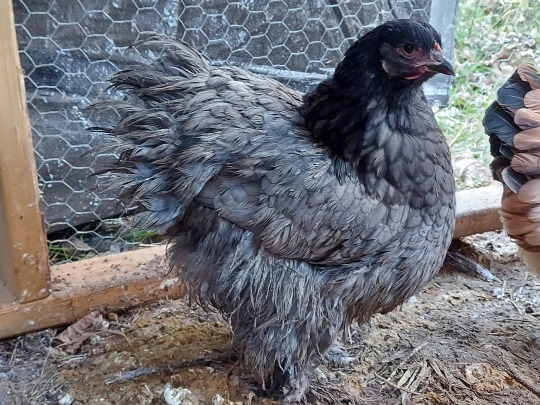
He's getting my barred hens, even though Basketball is probably done laying for life. He also gets my blue pullets. There's at least three really nice ones growing up. And when I say that, I think I mean that the blue hen pictured above is the best cochin I own. She also forgot what hygiene is, but the amount of mass she's gathering as she grows - and how forward and deep her breast is already - I'm excited for her specifically. And I really think my barred hen(s) have a lot to offer in the cushion department. They don't necessarily have the depth of cushion, but they're way fuller than anything else I have. The barreds just really lack foot feathering in comparison.
But his pen - his pen is where I crunch down on TYPE. No funny color business (though I would kill for a barred cockerel out of that pen ...). Just black, blue, and ... yeah that's probably all that'll hatch out of his pen.
IF I had space, I'd put the typiest cock with the blue hens. Whether that be black boy or one of the blues growing up now - even though that's really difficult to judge when cochins take tonever to grow up. And I'd put the next typiest cock with the barreds. So that I could keep it separate and actually know what the hell I was hatching out. I don't think I have that luxury.

Last big project is the partridge. And the partridge shouldn't even be a project, but their type begs it so. I have three partridge cockerels growing up - all of them better than their sire. I'll keep one. I have ... three? partridge pullets growing up. They're really just around because I haven't sold them yet. I sold all of my oldest partridge grow-outs from this year to pay for rabbit feed. I also have three partridge hens. The wyandotte gets two of those partridge. I want one or two under the partridge boy.
Because I also have a good handful of black pullets growing up out of the black boy and the partridge hens. I think I also have one cockerel, but he can go. I'm going to keep the typiest two and put them under the partridge cockerel. Sell everything that hatches out black, and hope that my partridge type improves and that the melonizers don't totally mess with the partridge pattern.
I also really would like to put the blue laced red wyandotte back under a partridge. I hatched out zero blue things out of her and my partridge from this year. My dad hatched out two. I know for a fact he's keeping the pullet, but even if he's not keeping the cockerel I can bet that he's gotten rid of him already. I really do want blue laced red cochins. So between this pen and the pen of silver laced blue things, I actually have a decent chance of making a blue laced red pen for next year.
.
OHMYDEAR. I forgot about my wheatens. Fuck. I have two gold wheaten maran pullets that I got from FFH to make wheaten cochin. I need to put THEM under one of the blue cockerels. Ha. Oh shit. They'll make 100% blue or black birds that carry for wheaten, but it'll just be like the f1 sussex cross from this year. I'm not a huge fan of gold wheaten. HOWEVER, I have a couple different directions that I can later go with wheaten: silver wheaten (or better yet, take the next step, add mahogany and have salmon cochin) AND FURNESS. Furness would be a project. A really big project by isolating the melanotic gene from the laced birds, and then adding that over top wheaten, but absolutely theoretically doable. But quite honestly, I'm ahead of myself. I'll be happy with gold wheaten in two years from now.
.
Big pens are absolutely going to the type flock and partridge flock. But I just need to figure out how I'm safely separating these guys to get started next spring.
(I just don't want to think about winter, let's be honest.)
6 notes
·
View notes